Evaluating the Relationship Between Employee Stress and Performance
VerifiedAdded on 2023/04/22
|8
|2820
|322
Essay
AI Summary
This essay critically evaluates the relationship between employee work-related stress and job performance, arguing that there is a direct, negative correlation. It posits that work pressure leads to mental health problems, difficulties in maintaining work-life balance, and a lack of appreciation from management, all of which negatively impact employee efficiency and dedication. The essay supports these arguments with references to various studies, highlighting the adverse effects of stress on physical health, decision-making abilities, and interpersonal relationships. It also discusses the importance of employee motivation and the application of Maslow's hierarchy of needs to mitigate stress and improve performance. The conclusion reinforces the idea that managing employee stress is crucial for boosting productivity and creating a positive work environment.
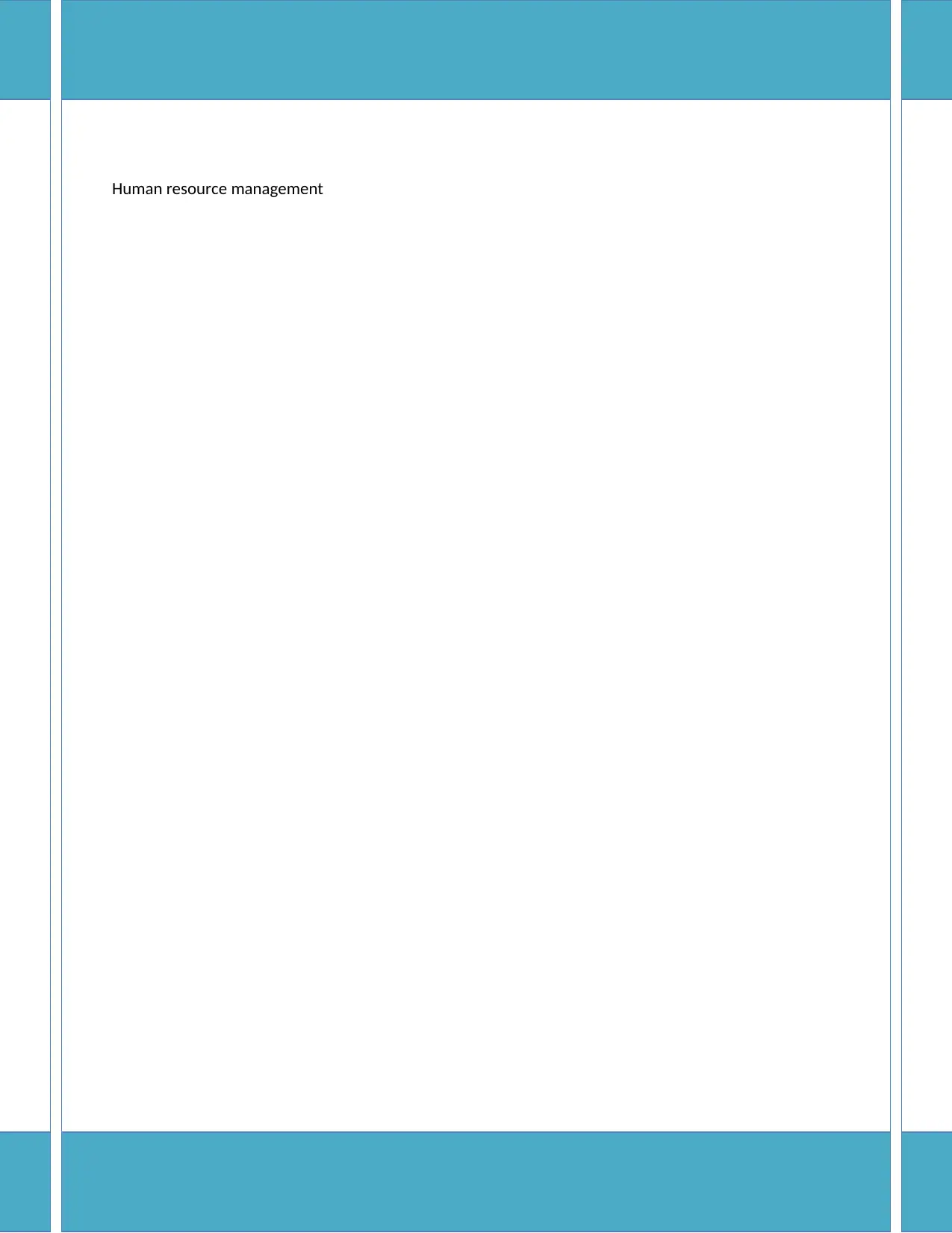
Human resource management
Paraphrase This Document
Need a fresh take? Get an instant paraphrase of this document with our AI Paraphraser
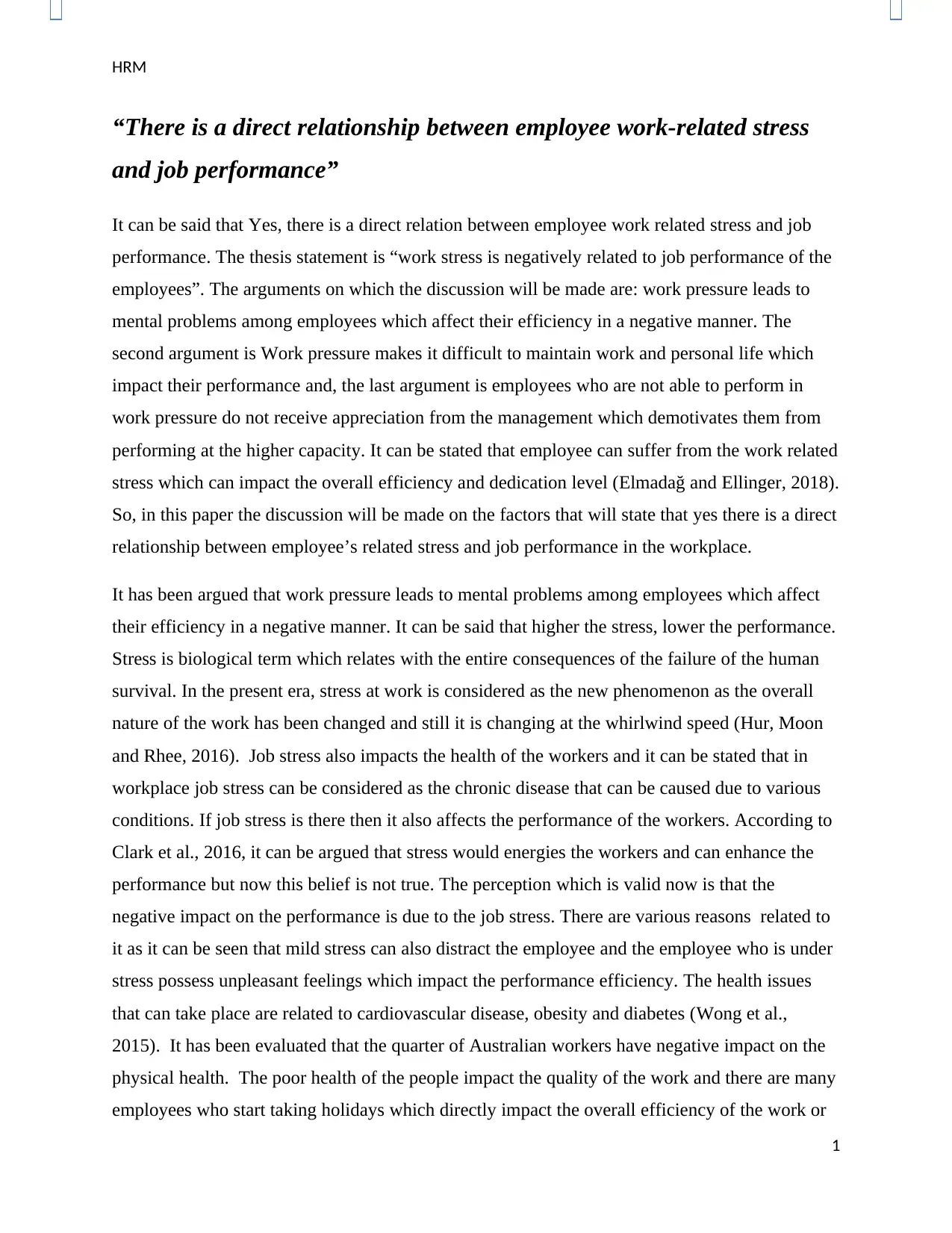
HRM
“There is a direct relationship between employee work-related stress
and job performance”
It can be said that Yes, there is a direct relation between employee work related stress and job
performance. The thesis statement is “work stress is negatively related to job performance of the
employees”. The arguments on which the discussion will be made are: work pressure leads to
mental problems among employees which affect their efficiency in a negative manner. The
second argument is Work pressure makes it difficult to maintain work and personal life which
impact their performance and, the last argument is employees who are not able to perform in
work pressure do not receive appreciation from the management which demotivates them from
performing at the higher capacity. It can be stated that employee can suffer from the work related
stress which can impact the overall efficiency and dedication level (Elmadağ and Ellinger, 2018).
So, in this paper the discussion will be made on the factors that will state that yes there is a direct
relationship between employee’s related stress and job performance in the workplace.
It has been argued that work pressure leads to mental problems among employees which affect
their efficiency in a negative manner. It can be said that higher the stress, lower the performance.
Stress is biological term which relates with the entire consequences of the failure of the human
survival. In the present era, stress at work is considered as the new phenomenon as the overall
nature of the work has been changed and still it is changing at the whirlwind speed (Hur, Moon
and Rhee, 2016). Job stress also impacts the health of the workers and it can be stated that in
workplace job stress can be considered as the chronic disease that can be caused due to various
conditions. If job stress is there then it also affects the performance of the workers. According to
Clark et al., 2016, it can be argued that stress would energies the workers and can enhance the
performance but now this belief is not true. The perception which is valid now is that the
negative impact on the performance is due to the job stress. There are various reasons related to
it as it can be seen that mild stress can also distract the employee and the employee who is under
stress possess unpleasant feelings which impact the performance efficiency. The health issues
that can take place are related to cardiovascular disease, obesity and diabetes (Wong et al.,
2015). It has been evaluated that the quarter of Australian workers have negative impact on the
physical health. The poor health of the people impact the quality of the work and there are many
employees who start taking holidays which directly impact the overall efficiency of the work or
1
“There is a direct relationship between employee work-related stress
and job performance”
It can be said that Yes, there is a direct relation between employee work related stress and job
performance. The thesis statement is “work stress is negatively related to job performance of the
employees”. The arguments on which the discussion will be made are: work pressure leads to
mental problems among employees which affect their efficiency in a negative manner. The
second argument is Work pressure makes it difficult to maintain work and personal life which
impact their performance and, the last argument is employees who are not able to perform in
work pressure do not receive appreciation from the management which demotivates them from
performing at the higher capacity. It can be stated that employee can suffer from the work related
stress which can impact the overall efficiency and dedication level (Elmadağ and Ellinger, 2018).
So, in this paper the discussion will be made on the factors that will state that yes there is a direct
relationship between employee’s related stress and job performance in the workplace.
It has been argued that work pressure leads to mental problems among employees which affect
their efficiency in a negative manner. It can be said that higher the stress, lower the performance.
Stress is biological term which relates with the entire consequences of the failure of the human
survival. In the present era, stress at work is considered as the new phenomenon as the overall
nature of the work has been changed and still it is changing at the whirlwind speed (Hur, Moon
and Rhee, 2016). Job stress also impacts the health of the workers and it can be stated that in
workplace job stress can be considered as the chronic disease that can be caused due to various
conditions. If job stress is there then it also affects the performance of the workers. According to
Clark et al., 2016, it can be argued that stress would energies the workers and can enhance the
performance but now this belief is not true. The perception which is valid now is that the
negative impact on the performance is due to the job stress. There are various reasons related to
it as it can be seen that mild stress can also distract the employee and the employee who is under
stress possess unpleasant feelings which impact the performance efficiency. The health issues
that can take place are related to cardiovascular disease, obesity and diabetes (Wong et al.,
2015). It has been evaluated that the quarter of Australian workers have negative impact on the
physical health. The poor health of the people impact the quality of the work and there are many
employees who start taking holidays which directly impact the overall efficiency of the work or
1
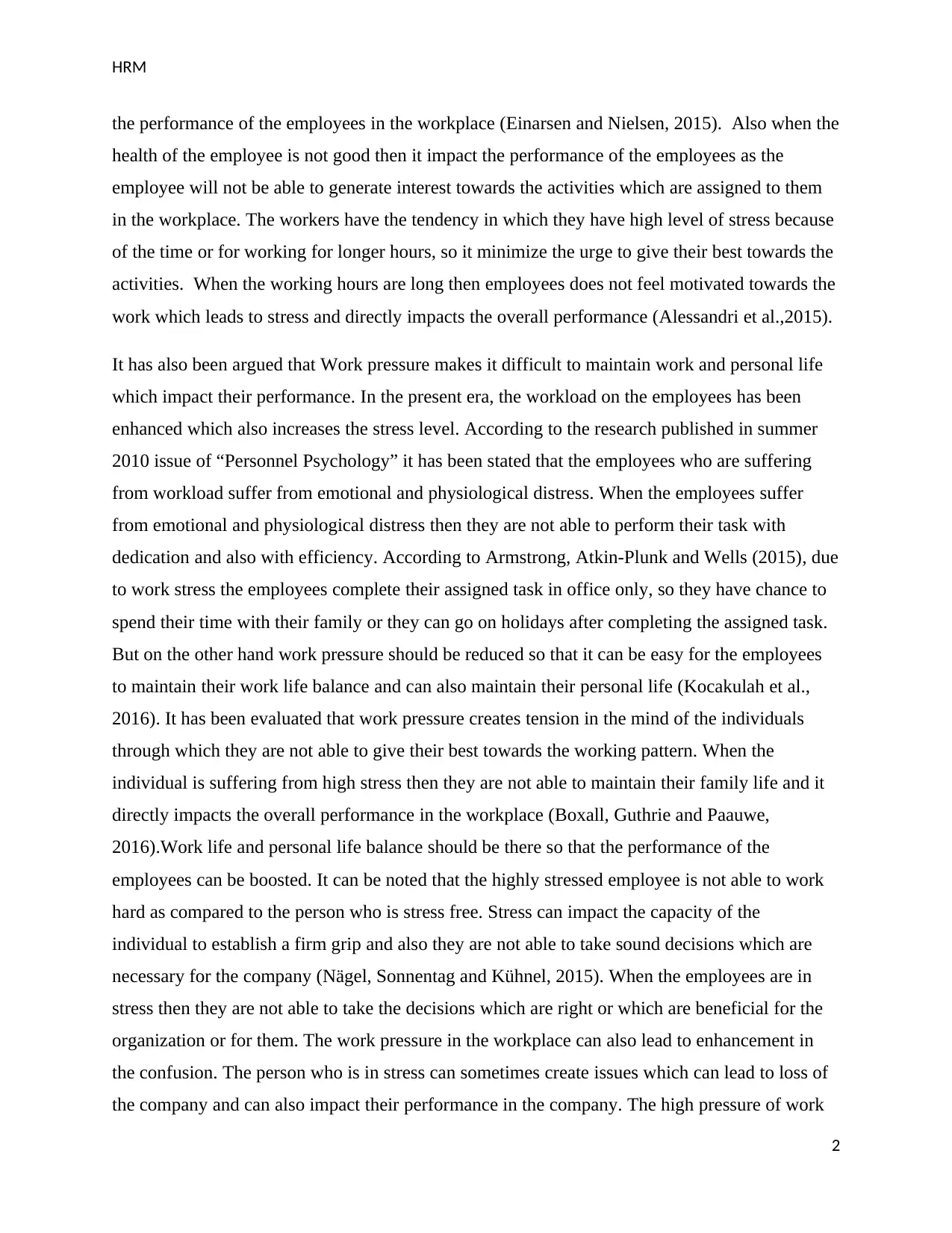
HRM
the performance of the employees in the workplace (Einarsen and Nielsen, 2015). Also when the
health of the employee is not good then it impact the performance of the employees as the
employee will not be able to generate interest towards the activities which are assigned to them
in the workplace. The workers have the tendency in which they have high level of stress because
of the time or for working for longer hours, so it minimize the urge to give their best towards the
activities. When the working hours are long then employees does not feel motivated towards the
work which leads to stress and directly impacts the overall performance (Alessandri et al.,2015).
It has also been argued that Work pressure makes it difficult to maintain work and personal life
which impact their performance. In the present era, the workload on the employees has been
enhanced which also increases the stress level. According to the research published in summer
2010 issue of “Personnel Psychology” it has been stated that the employees who are suffering
from workload suffer from emotional and physiological distress. When the employees suffer
from emotional and physiological distress then they are not able to perform their task with
dedication and also with efficiency. According to Armstrong, Atkin-Plunk and Wells (2015), due
to work stress the employees complete their assigned task in office only, so they have chance to
spend their time with their family or they can go on holidays after completing the assigned task.
But on the other hand work pressure should be reduced so that it can be easy for the employees
to maintain their work life balance and can also maintain their personal life (Kocakulah et al.,
2016). It has been evaluated that work pressure creates tension in the mind of the individuals
through which they are not able to give their best towards the working pattern. When the
individual is suffering from high stress then they are not able to maintain their family life and it
directly impacts the overall performance in the workplace (Boxall, Guthrie and Paauwe,
2016).Work life and personal life balance should be there so that the performance of the
employees can be boosted. It can be noted that the highly stressed employee is not able to work
hard as compared to the person who is stress free. Stress can impact the capacity of the
individual to establish a firm grip and also they are not able to take sound decisions which are
necessary for the company (Nägel, Sonnentag and Kühnel, 2015). When the employees are in
stress then they are not able to take the decisions which are right or which are beneficial for the
organization or for them. The work pressure in the workplace can also lead to enhancement in
the confusion. The person who is in stress can sometimes create issues which can lead to loss of
the company and can also impact their performance in the company. The high pressure of work
2
the performance of the employees in the workplace (Einarsen and Nielsen, 2015). Also when the
health of the employee is not good then it impact the performance of the employees as the
employee will not be able to generate interest towards the activities which are assigned to them
in the workplace. The workers have the tendency in which they have high level of stress because
of the time or for working for longer hours, so it minimize the urge to give their best towards the
activities. When the working hours are long then employees does not feel motivated towards the
work which leads to stress and directly impacts the overall performance (Alessandri et al.,2015).
It has also been argued that Work pressure makes it difficult to maintain work and personal life
which impact their performance. In the present era, the workload on the employees has been
enhanced which also increases the stress level. According to the research published in summer
2010 issue of “Personnel Psychology” it has been stated that the employees who are suffering
from workload suffer from emotional and physiological distress. When the employees suffer
from emotional and physiological distress then they are not able to perform their task with
dedication and also with efficiency. According to Armstrong, Atkin-Plunk and Wells (2015), due
to work stress the employees complete their assigned task in office only, so they have chance to
spend their time with their family or they can go on holidays after completing the assigned task.
But on the other hand work pressure should be reduced so that it can be easy for the employees
to maintain their work life balance and can also maintain their personal life (Kocakulah et al.,
2016). It has been evaluated that work pressure creates tension in the mind of the individuals
through which they are not able to give their best towards the working pattern. When the
individual is suffering from high stress then they are not able to maintain their family life and it
directly impacts the overall performance in the workplace (Boxall, Guthrie and Paauwe,
2016).Work life and personal life balance should be there so that the performance of the
employees can be boosted. It can be noted that the highly stressed employee is not able to work
hard as compared to the person who is stress free. Stress can impact the capacity of the
individual to establish a firm grip and also they are not able to take sound decisions which are
necessary for the company (Nägel, Sonnentag and Kühnel, 2015). When the employees are in
stress then they are not able to take the decisions which are right or which are beneficial for the
organization or for them. The work pressure in the workplace can also lead to enhancement in
the confusion. The person who is in stress can sometimes create issues which can lead to loss of
the company and can also impact their performance in the company. The high pressure of work
2
⊘ This is a preview!⊘
Do you want full access?
Subscribe today to unlock all pages.

Trusted by 1+ million students worldwide
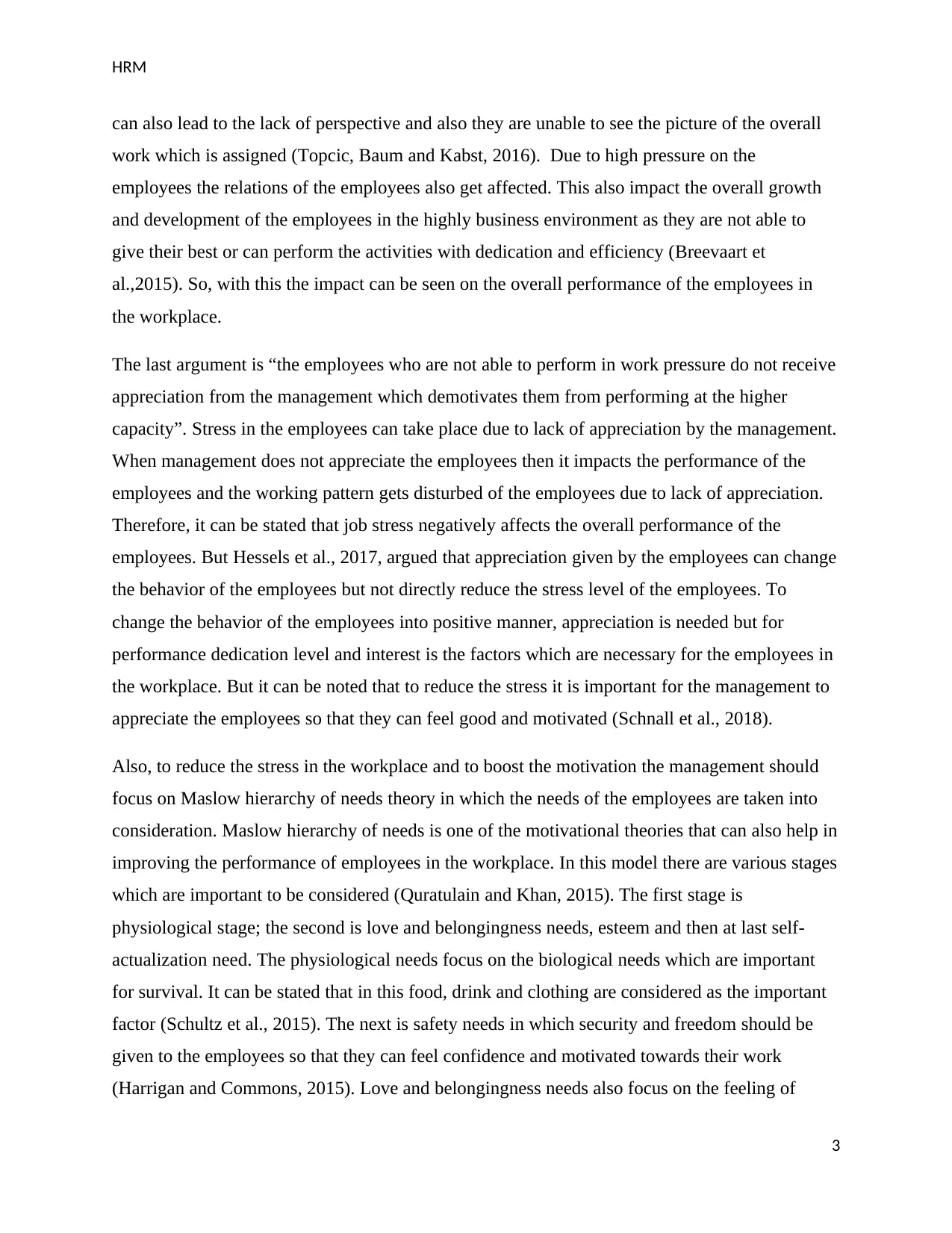
HRM
can also lead to the lack of perspective and also they are unable to see the picture of the overall
work which is assigned (Topcic, Baum and Kabst, 2016). Due to high pressure on the
employees the relations of the employees also get affected. This also impact the overall growth
and development of the employees in the highly business environment as they are not able to
give their best or can perform the activities with dedication and efficiency (Breevaart et
al.,2015). So, with this the impact can be seen on the overall performance of the employees in
the workplace.
The last argument is “the employees who are not able to perform in work pressure do not receive
appreciation from the management which demotivates them from performing at the higher
capacity”. Stress in the employees can take place due to lack of appreciation by the management.
When management does not appreciate the employees then it impacts the performance of the
employees and the working pattern gets disturbed of the employees due to lack of appreciation.
Therefore, it can be stated that job stress negatively affects the overall performance of the
employees. But Hessels et al., 2017, argued that appreciation given by the employees can change
the behavior of the employees but not directly reduce the stress level of the employees. To
change the behavior of the employees into positive manner, appreciation is needed but for
performance dedication level and interest is the factors which are necessary for the employees in
the workplace. But it can be noted that to reduce the stress it is important for the management to
appreciate the employees so that they can feel good and motivated (Schnall et al., 2018).
Also, to reduce the stress in the workplace and to boost the motivation the management should
focus on Maslow hierarchy of needs theory in which the needs of the employees are taken into
consideration. Maslow hierarchy of needs is one of the motivational theories that can also help in
improving the performance of employees in the workplace. In this model there are various stages
which are important to be considered (Quratulain and Khan, 2015). The first stage is
physiological stage; the second is love and belongingness needs, esteem and then at last self-
actualization need. The physiological needs focus on the biological needs which are important
for survival. It can be stated that in this food, drink and clothing are considered as the important
factor (Schultz et al., 2015). The next is safety needs in which security and freedom should be
given to the employees so that they can feel confidence and motivated towards their work
(Harrigan and Commons, 2015). Love and belongingness needs also focus on the feeling of
3
can also lead to the lack of perspective and also they are unable to see the picture of the overall
work which is assigned (Topcic, Baum and Kabst, 2016). Due to high pressure on the
employees the relations of the employees also get affected. This also impact the overall growth
and development of the employees in the highly business environment as they are not able to
give their best or can perform the activities with dedication and efficiency (Breevaart et
al.,2015). So, with this the impact can be seen on the overall performance of the employees in
the workplace.
The last argument is “the employees who are not able to perform in work pressure do not receive
appreciation from the management which demotivates them from performing at the higher
capacity”. Stress in the employees can take place due to lack of appreciation by the management.
When management does not appreciate the employees then it impacts the performance of the
employees and the working pattern gets disturbed of the employees due to lack of appreciation.
Therefore, it can be stated that job stress negatively affects the overall performance of the
employees. But Hessels et al., 2017, argued that appreciation given by the employees can change
the behavior of the employees but not directly reduce the stress level of the employees. To
change the behavior of the employees into positive manner, appreciation is needed but for
performance dedication level and interest is the factors which are necessary for the employees in
the workplace. But it can be noted that to reduce the stress it is important for the management to
appreciate the employees so that they can feel good and motivated (Schnall et al., 2018).
Also, to reduce the stress in the workplace and to boost the motivation the management should
focus on Maslow hierarchy of needs theory in which the needs of the employees are taken into
consideration. Maslow hierarchy of needs is one of the motivational theories that can also help in
improving the performance of employees in the workplace. In this model there are various stages
which are important to be considered (Quratulain and Khan, 2015). The first stage is
physiological stage; the second is love and belongingness needs, esteem and then at last self-
actualization need. The physiological needs focus on the biological needs which are important
for survival. It can be stated that in this food, drink and clothing are considered as the important
factor (Schultz et al., 2015). The next is safety needs in which security and freedom should be
given to the employees so that they can feel confidence and motivated towards their work
(Harrigan and Commons, 2015). Love and belongingness needs also focus on the feeling of
3
Paraphrase This Document
Need a fresh take? Get an instant paraphrase of this document with our AI Paraphraser

HRM
belongingness. In this need for the interpersonal relations are necessary as it motivate the
behavior of the individual. Trust should be maintained of the employees and management in the
workplace (Methot et al., 2016). The next is esteem need in which the emphasis is on dignity and
achievement which can help in enhancing the performance of the employees. The last is self-
actualization needs in which the potential and also personal growth is considered of the
employees. If there is growth if the employees then it can be simple to boost the performance and
also it reduces the stress of the employees in the workplace (Wang, Lu and Siu, 2015). When
these needs are fulfilled of the employees in the workplace then it can be easy to boost the
performance and also it will reduce the stress in the workplace. It has been stated by Harding
(2017), motivation can help in boosting the overall performance of the employees and also it
reduces the stress which can lead to positive outcome in the highly competitive market.
Motivation given to the employees can help in boosting the efficiency and also interest towards
the assigned work.
So, by analyzing the paper it can be concluded that there is a direct relationship between work
related stress and job performance. If the employees are suffering from work stress then it
impacts their efficiency and also there are not able to create interest towards the work. It has
been noted that due to stress people has to suffer from the health issues which impact their
efficiency towards the work. Also, when there is stress related to work then it is difficult for the
employees to maintain their work and personal life as employees are not able to think in one
direction and can impact the overall working pattern in the business environment. Also, the
employees who are not able to work in the work pressure are not motivated by the employees
that also create stress and can lead low productivity. So, it can be stated that motivation is one of
the factor that should be considered so that stress level of the employees can be minimized and
productivity level can also be boosted.
4
belongingness. In this need for the interpersonal relations are necessary as it motivate the
behavior of the individual. Trust should be maintained of the employees and management in the
workplace (Methot et al., 2016). The next is esteem need in which the emphasis is on dignity and
achievement which can help in enhancing the performance of the employees. The last is self-
actualization needs in which the potential and also personal growth is considered of the
employees. If there is growth if the employees then it can be simple to boost the performance and
also it reduces the stress of the employees in the workplace (Wang, Lu and Siu, 2015). When
these needs are fulfilled of the employees in the workplace then it can be easy to boost the
performance and also it will reduce the stress in the workplace. It has been stated by Harding
(2017), motivation can help in boosting the overall performance of the employees and also it
reduces the stress which can lead to positive outcome in the highly competitive market.
Motivation given to the employees can help in boosting the efficiency and also interest towards
the assigned work.
So, by analyzing the paper it can be concluded that there is a direct relationship between work
related stress and job performance. If the employees are suffering from work stress then it
impacts their efficiency and also there are not able to create interest towards the work. It has
been noted that due to stress people has to suffer from the health issues which impact their
efficiency towards the work. Also, when there is stress related to work then it is difficult for the
employees to maintain their work and personal life as employees are not able to think in one
direction and can impact the overall working pattern in the business environment. Also, the
employees who are not able to work in the work pressure are not motivated by the employees
that also create stress and can lead low productivity. So, it can be stated that motivation is one of
the factor that should be considered so that stress level of the employees can be minimized and
productivity level can also be boosted.
4
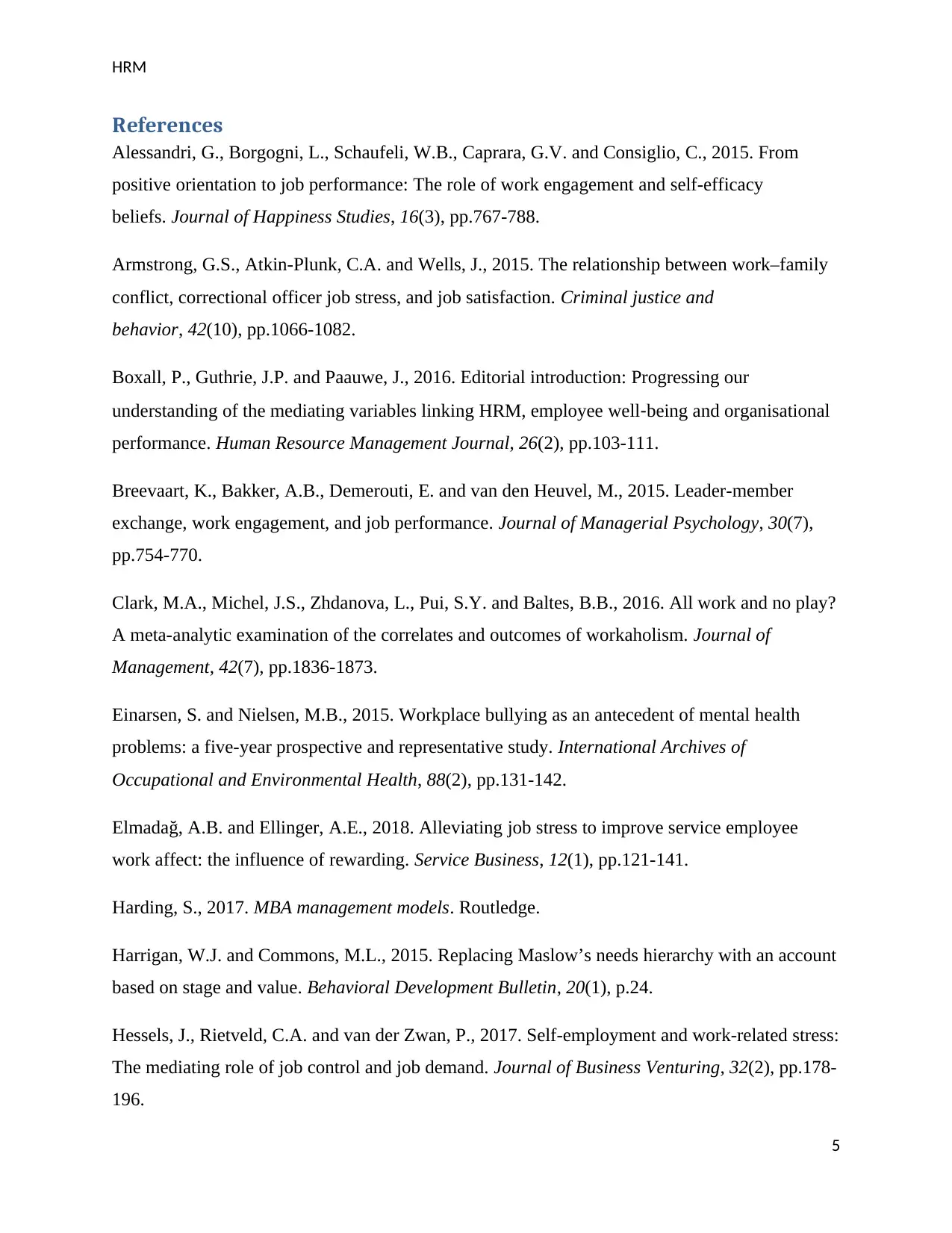
HRM
References
Alessandri, G., Borgogni, L., Schaufeli, W.B., Caprara, G.V. and Consiglio, C., 2015. From
positive orientation to job performance: The role of work engagement and self-efficacy
beliefs. Journal of Happiness Studies, 16(3), pp.767-788.
Armstrong, G.S., Atkin-Plunk, C.A. and Wells, J., 2015. The relationship between work–family
conflict, correctional officer job stress, and job satisfaction. Criminal justice and
behavior, 42(10), pp.1066-1082.
Boxall, P., Guthrie, J.P. and Paauwe, J., 2016. Editorial introduction: Progressing our
understanding of the mediating variables linking HRM, employee well‐being and organisational
performance. Human Resource Management Journal, 26(2), pp.103-111.
Breevaart, K., Bakker, A.B., Demerouti, E. and van den Heuvel, M., 2015. Leader-member
exchange, work engagement, and job performance. Journal of Managerial Psychology, 30(7),
pp.754-770.
Clark, M.A., Michel, J.S., Zhdanova, L., Pui, S.Y. and Baltes, B.B., 2016. All work and no play?
A meta-analytic examination of the correlates and outcomes of workaholism. Journal of
Management, 42(7), pp.1836-1873.
Einarsen, S. and Nielsen, M.B., 2015. Workplace bullying as an antecedent of mental health
problems: a five-year prospective and representative study. International Archives of
Occupational and Environmental Health, 88(2), pp.131-142.
Elmadağ, A.B. and Ellinger, A.E., 2018. Alleviating job stress to improve service employee
work affect: the influence of rewarding. Service Business, 12(1), pp.121-141.
Harding, S., 2017. MBA management models. Routledge.
Harrigan, W.J. and Commons, M.L., 2015. Replacing Maslow’s needs hierarchy with an account
based on stage and value. Behavioral Development Bulletin, 20(1), p.24.
Hessels, J., Rietveld, C.A. and van der Zwan, P., 2017. Self-employment and work-related stress:
The mediating role of job control and job demand. Journal of Business Venturing, 32(2), pp.178-
196.
5
References
Alessandri, G., Borgogni, L., Schaufeli, W.B., Caprara, G.V. and Consiglio, C., 2015. From
positive orientation to job performance: The role of work engagement and self-efficacy
beliefs. Journal of Happiness Studies, 16(3), pp.767-788.
Armstrong, G.S., Atkin-Plunk, C.A. and Wells, J., 2015. The relationship between work–family
conflict, correctional officer job stress, and job satisfaction. Criminal justice and
behavior, 42(10), pp.1066-1082.
Boxall, P., Guthrie, J.P. and Paauwe, J., 2016. Editorial introduction: Progressing our
understanding of the mediating variables linking HRM, employee well‐being and organisational
performance. Human Resource Management Journal, 26(2), pp.103-111.
Breevaart, K., Bakker, A.B., Demerouti, E. and van den Heuvel, M., 2015. Leader-member
exchange, work engagement, and job performance. Journal of Managerial Psychology, 30(7),
pp.754-770.
Clark, M.A., Michel, J.S., Zhdanova, L., Pui, S.Y. and Baltes, B.B., 2016. All work and no play?
A meta-analytic examination of the correlates and outcomes of workaholism. Journal of
Management, 42(7), pp.1836-1873.
Einarsen, S. and Nielsen, M.B., 2015. Workplace bullying as an antecedent of mental health
problems: a five-year prospective and representative study. International Archives of
Occupational and Environmental Health, 88(2), pp.131-142.
Elmadağ, A.B. and Ellinger, A.E., 2018. Alleviating job stress to improve service employee
work affect: the influence of rewarding. Service Business, 12(1), pp.121-141.
Harding, S., 2017. MBA management models. Routledge.
Harrigan, W.J. and Commons, M.L., 2015. Replacing Maslow’s needs hierarchy with an account
based on stage and value. Behavioral Development Bulletin, 20(1), p.24.
Hessels, J., Rietveld, C.A. and van der Zwan, P., 2017. Self-employment and work-related stress:
The mediating role of job control and job demand. Journal of Business Venturing, 32(2), pp.178-
196.
5
⊘ This is a preview!⊘
Do you want full access?
Subscribe today to unlock all pages.

Trusted by 1+ million students worldwide

HRM
Hur, W.M., Moon, T. and Rhee, S.Y., 2016. Exploring the relationships between compassion at
work, the evaluative perspective of positive work-related identity, service employee creativity,
and job performance. Journal of Services Marketing, 30(1), pp.103-114.
Kocakulah, M.C., Kelley, A.G., Mitchell, K.M. and Ruggieri, M.P., 2016. Absenteeism
problems and costs: causes, effects and cures. The International Business & Economics Research
Journal (Online), 15(3), p.89.
Methot, J.R., Lepine, J.A., Podsakoff, N.P. and Christian, J.S., 2016. Are workplace friendships
a mixed blessing? Exploring tradeoffs of multiplex relationships and their associations with job
performance. Personnel psychology, 69(2), pp.311-355.
Nägel, I.J., Sonnentag, S. and Kühnel, J., 2015. Motives matter: A diary study on the relationship
between job stressors and exercise after work. International Journal of Stress
Management, 22(4), p.346.
Quratulain, S. and Khan, A.K., 2015. How does employees’ public service motivation get
affected? A conditional process analysis of the effects of person–job fit and work
pressure. Public Personnel Management, 44(2), pp.266-289.
Schnall, P.L., Dobson, M., Rosskam, E. and Elling, R.H., 2018. Unhealthy work: Causes,
consequences, cures. Routledge.
Schultz, P.P., Ryan, R.M., Niemiec, C.P., Legate, N. and Williams, G.C., 2015. Mindfulness,
work climate, and psychological need satisfaction in employee well-being. Mindfulness, 6(5),
pp.971-985.
Topcic, M., Baum, M. and Kabst, R., 2016. Are high-performance work practices related to
individually perceived stress? A job demands-resources perspective. The International Journal
of Human Resource Management, 27(1), pp.45-66.
Wang, H.J., Lu, C.Q. and Siu, O.L., 2015. Job insecurity and job performance: The moderating
role of organizational justice and the mediating role of work engagement. Journal of Applied
Psychology, 100(4), p.1249.
6
Hur, W.M., Moon, T. and Rhee, S.Y., 2016. Exploring the relationships between compassion at
work, the evaluative perspective of positive work-related identity, service employee creativity,
and job performance. Journal of Services Marketing, 30(1), pp.103-114.
Kocakulah, M.C., Kelley, A.G., Mitchell, K.M. and Ruggieri, M.P., 2016. Absenteeism
problems and costs: causes, effects and cures. The International Business & Economics Research
Journal (Online), 15(3), p.89.
Methot, J.R., Lepine, J.A., Podsakoff, N.P. and Christian, J.S., 2016. Are workplace friendships
a mixed blessing? Exploring tradeoffs of multiplex relationships and their associations with job
performance. Personnel psychology, 69(2), pp.311-355.
Nägel, I.J., Sonnentag, S. and Kühnel, J., 2015. Motives matter: A diary study on the relationship
between job stressors and exercise after work. International Journal of Stress
Management, 22(4), p.346.
Quratulain, S. and Khan, A.K., 2015. How does employees’ public service motivation get
affected? A conditional process analysis of the effects of person–job fit and work
pressure. Public Personnel Management, 44(2), pp.266-289.
Schnall, P.L., Dobson, M., Rosskam, E. and Elling, R.H., 2018. Unhealthy work: Causes,
consequences, cures. Routledge.
Schultz, P.P., Ryan, R.M., Niemiec, C.P., Legate, N. and Williams, G.C., 2015. Mindfulness,
work climate, and psychological need satisfaction in employee well-being. Mindfulness, 6(5),
pp.971-985.
Topcic, M., Baum, M. and Kabst, R., 2016. Are high-performance work practices related to
individually perceived stress? A job demands-resources perspective. The International Journal
of Human Resource Management, 27(1), pp.45-66.
Wang, H.J., Lu, C.Q. and Siu, O.L., 2015. Job insecurity and job performance: The moderating
role of organizational justice and the mediating role of work engagement. Journal of Applied
Psychology, 100(4), p.1249.
6
Paraphrase This Document
Need a fresh take? Get an instant paraphrase of this document with our AI Paraphraser

HRM
Wong, C.A., Elliott‐Miller, P., Laschinger, H., Cuddihy, M., Meyer, R.M., Keatings, M.,
Burnett, C. and Szudy, N., 2015. Examining the relationships between span of control and
manager job and unit performance outcomes. Journal of nursing management, 23(2), pp.156-
168.
7
Wong, C.A., Elliott‐Miller, P., Laschinger, H., Cuddihy, M., Meyer, R.M., Keatings, M.,
Burnett, C. and Szudy, N., 2015. Examining the relationships between span of control and
manager job and unit performance outcomes. Journal of nursing management, 23(2), pp.156-
168.
7
1 out of 8
Related Documents
Your All-in-One AI-Powered Toolkit for Academic Success.
+13062052269
info@desklib.com
Available 24*7 on WhatsApp / Email
![[object Object]](/_next/static/media/star-bottom.7253800d.svg)
Unlock your academic potential
Copyright © 2020–2025 A2Z Services. All Rights Reserved. Developed and managed by ZUCOL.





